|
|
 |
Imperial tombs are not only found in Egypt - although the pyramids are the most impressive burial sites of the world.
Every Chinese Dynasty buried their rulers near the capital town in a large area, mounds were erected for the ruler and his empress, princes and consorts. But we find also the tombs of local officials and governors scattered all over China. Probably the most famous tomb finding of China in the last years was the tomb of Mawangdui 馬王堆 in Hunan, the grave of a Han Dynasty lady. Like the famous tomb of the Egyptian Pharao Tutanchamun, Chinese tombs contain burying offerings counting up to the hundreds. Already the Shang 商 kings had themselves buried together with expensive bronze vessels and jade objects (see picture to the right)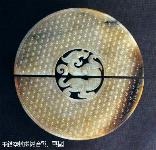 , symbolizing the relationship between the sacred king and the deities. But the Shang tombs also contained the bodies of dozens of horses, slaves and concubines only killed to follow their master to the neither world. Later burials were not that bloody. There are almost no traces of Zhou Dynasty 周 tombs or the tombs of the feudal lords of the Zhou period. Qin 秦 tombs (the only one being the famous Shihuangling 始皇陵) and Han 漢 tombs (the largest being the tomb of Han Wudi 漢武帝, Han Maoling 漢茂陵) are located near their respective capitals Xianyang 咸陽, Chang'an 長安 (modern Xi'an) and Luoyang 洛陽. But we can also find many tombs of local officials and princes of the Han period. The next area dotted with imperial tombs is the region around Nanjing 南京 where the Southern Dynasties 南朝 had their capital. Tang Dynasty 唐 tombs (the largest is the Tang Qianling 唐乾陵, tomb of Tang Gaozong 唐高宗 and Empress Wu Zetian 武則天) again can be found near Xi'an. Ming 明 and Qing 清 rulers tombs can be found in Beijing, except the first Ming ruler who is buried in Nanjing (Ming Xiaoling 明孝陵). The "Father of China" Guofu 國父, President Sun Yat-sen (or Sun Zhongshan 孫中山) has a large tomb in Nanjing. While the dictator Chiang Kai-shek 蔣介石 as a Christian has a very silent tomb in a remote village near Taibei/Taiwan, the great leader of the People's Republic, Mao Zedong 毛澤東, is buried in a real socialist manner in his mausoleum (Mao Zhuxi jiniantang 毛主席紀念堂) on the Tiananmen Square, that is modeled after Lenin's tomb at the Kremlin wall. , symbolizing the relationship between the sacred king and the deities. But the Shang tombs also contained the bodies of dozens of horses, slaves and concubines only killed to follow their master to the neither world. Later burials were not that bloody. There are almost no traces of Zhou Dynasty 周 tombs or the tombs of the feudal lords of the Zhou period. Qin 秦 tombs (the only one being the famous Shihuangling 始皇陵) and Han 漢 tombs (the largest being the tomb of Han Wudi 漢武帝, Han Maoling 漢茂陵) are located near their respective capitals Xianyang 咸陽, Chang'an 長安 (modern Xi'an) and Luoyang 洛陽. But we can also find many tombs of local officials and princes of the Han period. The next area dotted with imperial tombs is the region around Nanjing 南京 where the Southern Dynasties 南朝 had their capital. Tang Dynasty 唐 tombs (the largest is the Tang Qianling 唐乾陵, tomb of Tang Gaozong 唐高宗 and Empress Wu Zetian 武則天) again can be found near Xi'an. Ming 明 and Qing 清 rulers tombs can be found in Beijing, except the first Ming ruler who is buried in Nanjing (Ming Xiaoling 明孝陵). The "Father of China" Guofu 國父, President Sun Yat-sen (or Sun Zhongshan 孫中山) has a large tomb in Nanjing. While the dictator Chiang Kai-shek 蔣介石 as a Christian has a very silent tomb in a remote village near Taibei/Taiwan, the great leader of the People's Republic, Mao Zedong 毛澤東, is buried in a real socialist manner in his mausoleum (Mao Zhuxi jiniantang 毛主席紀念堂) on the Tiananmen Square, that is modeled after Lenin's tomb at the Kremlin wall.
Like every other building in China, even tombs are directed according to the pattern of Fengshui 風水 "wind and water" to employ the auspicious and impede the inauspicious influences of nature and spirits: the tomb is lying on the southern slope of a mountain and can be accessed by crossing a river or creek. There is a basic writing about tomb Fengshui called Zangshu 葬書 "Book of burial". The main gate is a symbolic honorific gate (or paifang 牌坊) with five entrances and a tower-like building (pailou 牌樓 or que 闕). From this gate, a "soul path" or "sacred way" (shendao 神道) leads northwards, flanked by stone sculptures of officials (wenguan 文官), generals (wuguan 武官) and different animals like horses, elephants, camels and fabulous beasts (qilin 麒麟, tianlu 天祿). The first hall is in most cases a small entrance hall, followed by the main hall (zhengdian 正殿) that serves for veneration when the descendants of the tomb's owner pray to his soul for luck and harmony. The tomb itself is the most northern part, the building is shaped like a tower, the body and tomb offerings are contained in a tunnel-like room beneath the earth. This room is not, like in Egypt, necessarily closed. To keep the tomb intact, a whole village is employed with the different tasks needed to keep up the memorial of the deceased. North to the tomb is a burial mound, natural or artificial - if the tomb chamber is inside the mound, the entrance is on the south slope of the hill. Most burial sites are dottes with tombs of the emperors. Princes, princesses, consorts and sometimes highest ministers were buried in "satellite" tombs around the central tomb.
The oldest tombs of China date from the Shang dynasty. The Shang kings and persons of the nobility were buried in a shaft tomb with two ramps leading down. An artificial hill covered the burying site. The corpse of the dead persons was sometimes coated with a jade clothing (see picture)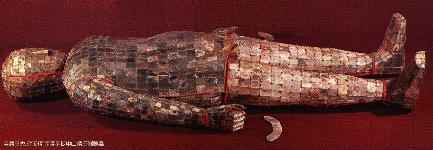 , a material thought to be able protecting the corpse from decomposition. , a material thought to be able protecting the corpse from decomposition.
With the advent of Buddhism in China, the use of burning the corpse became widespread among the average population. The urns are kept in a small familiy cemetery in an appropriate location on the southern slope of a hill. The grave stone (bei 碑) is very simple and unadorned, before it is only small room for the pot containing incense sticks. Only the highest nobility is buried in a sarcophagus (guanguo 棺椁), and only these officials or nobles are granted a longer inscription on their tombstones (beiming 碑銘, aice 哀冊).
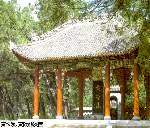 |
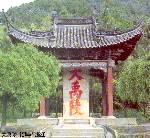 The two buildings in this row are not necessarily tombs but rather memorials for mythic persons like the building on the left, a pavillion for veneration of the Yellow Emperor (Huangdi 黃帝) in Huangling 黃陵/Shaanxi, the right pavillion near Shaoxing 紹興/Zhejiang being the "tomb" of emperor Yu the Great 大禹 who tamed the inundating rivers and divided China into nine provinces (see mythology). Nearby is a temple complex. The two buildings in this row are not necessarily tombs but rather memorials for mythic persons like the building on the left, a pavillion for veneration of the Yellow Emperor (Huangdi 黃帝) in Huangling 黃陵/Shaanxi, the right pavillion near Shaoxing 紹興/Zhejiang being the "tomb" of emperor Yu the Great 大禹 who tamed the inundating rivers and divided China into nine provinces (see mythology). Nearby is a temple complex. |
 |
As an extarordinarily important person for Chinese culture and philosophy, Confucius (Kongzi 孔子, "Master Kong") is venerated as the ancestor of all teachers and saint for all students. His home is in Qufu 曲阜/Shandong where he was born and his descendants lived for generations in a residence called Kongfu 孔府. Confucius is buried under a very simple mound with an austere tomb stone (picture to the left). His disciples and descendants are buried in a large area called Konglin 孔林 "Forest of the Kong family". The temple for the great saint of Confucianism (Kongmiao 孔廟) can be found in the middle of the town of Qufu.
The second important person of old Confucianism is Mengzi 孟子 (Mencius) who is buried in Zouxian 鄒縣, a small village 25 km south of Qufu. |
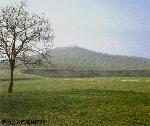
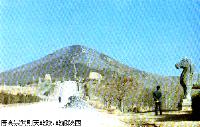 |
The First Emperor of China, Qin Shihuangdi 秦始皇帝, had erected a huge burying mound (Qin Shihuang Ling 秦始皇陵) near his capital in Xianyang 咸陽/Shaanxi. The historiographers describe the interior of his mound as containing mercury rivers, and automatical weapons killing robbers. To protect his realm of the neither world, a huge terracotta army (bingmayong 兵馬俑) was crafted and buried near the emperor's mound.
The largest necropolis ("dead city") of China is Mound Qianling 唐乾陵 "Celestial Tomb" near Qianxian 乾縣/Shaanxi for Emperor Tang Gaozong 唐高宗 and his empress Wu Zetian 武則天. Princes, princesses and high officials of the Tang emperors were buried in smaller mounds nearby. The huge stone sculptures of the "soul path" are still intact. |
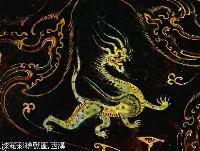 |
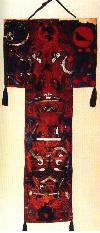 In recent years, a finding near Changsha/Hunan presented to us not only the well-preserved left-overs of a Han Dynasty lady, the Marquise of Dai, but we were also impressed by the rich offerings of literature that was given to the lady as lecture for the neither world: the Mawangdui 馬王堆 silk manuscripts (boshu 帛書), some of the oldest originals of Chinese literature, like the Daodejing 道德經 and Yijing 易經. The picture to the left gives an impression of the rich lacquer decoration of her coffin, the picture to the right is the "soul banner" of the lady that was laid upon the coffin. In recent years, a finding near Changsha/Hunan presented to us not only the well-preserved left-overs of a Han Dynasty lady, the Marquise of Dai, but we were also impressed by the rich offerings of literature that was given to the lady as lecture for the neither world: the Mawangdui 馬王堆 silk manuscripts (boshu 帛書), some of the oldest originals of Chinese literature, like the Daodejing 道德經 and Yijing 易經. The picture to the left gives an impression of the rich lacquer decoration of her coffin, the picture to the right is the "soul banner" of the lady that was laid upon the coffin. |
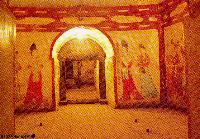 |
Some of the Tang 唐 tombs are decorated with wonderful wall paintings (bihua 壁畫)depicting scenes of the daily life of the aristocracy. Court ladies and warriors meet in the neither world to revive their life full of extravagancies. The left picture is from the tomb of Princess Yongtai 永泰公主 in Qianxian 乾縣/Shaanxi, a daughter of Emperor Tang Zhongzong 唐中宗, murdered by Empress Wu Zetian 武則天. Nearby are some other tombs that can be visited, like Zhaoling 唐昭陵, the tomb of Tang Taizong 唐太宗, the tomb of Prince Zhanghuai 章懐王, a son of Tang Gaozong 唐高宗 and Empress Wu Zetian, the tomb of Prince Yide 懿德王, Maoling 漢茂陵, the tomb of Emperor Han Wudi 漢武帝, and the tombs of Tang Xuanzong 唐玄宗 and his concubine Yang Guifei 楊貴妃. |
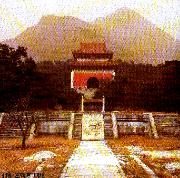 |
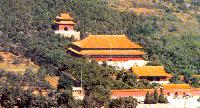 The most famous tombs of old China are the Ming 明 and Qing 清 tombs near Beijing. The tomb of the first Ming emperor (Ming Xiaoling 明孝陵), Zhu Yuanzhang 朱元璋 (reign motto Hongwu 洪武), is east of Nanjing, the early Ming capital. Most parts of his tomb are still intanct, but the tomb tower itself is only partially preserved. The tomb tower (upper left picture) is the entrance to Ming Yongling 明永陵, the tomb of Ming Shizong 明世宗, standing on a platform and erected south to a hill. Emperor Ming Chengzu 明成祖 (reign motto Yongle 永樂) moved the capital to Beijing and was the first emperor who had built his tomb ground, Ming Changling 明長陵 "Long-lasting Tomb", near Beijing. The buildings have been reconstructed, but the tomb itself is still untouched. The three courts are enclosed by a wall. The picture to the right clearly shows the three buildings inside the enclosure, the small buildings to the right being the first, served as storage for offering tools and objects, the second being the main hall for veneration, the tower-like building on the top is the main entrance of the subterranean tomb. The most famous tombs of old China are the Ming 明 and Qing 清 tombs near Beijing. The tomb of the first Ming emperor (Ming Xiaoling 明孝陵), Zhu Yuanzhang 朱元璋 (reign motto Hongwu 洪武), is east of Nanjing, the early Ming capital. Most parts of his tomb are still intanct, but the tomb tower itself is only partially preserved. The tomb tower (upper left picture) is the entrance to Ming Yongling 明永陵, the tomb of Ming Shizong 明世宗, standing on a platform and erected south to a hill. Emperor Ming Chengzu 明成祖 (reign motto Yongle 永樂) moved the capital to Beijing and was the first emperor who had built his tomb ground, Ming Changling 明長陵 "Long-lasting Tomb", near Beijing. The buildings have been reconstructed, but the tomb itself is still untouched. The three courts are enclosed by a wall. The picture to the right clearly shows the three buildings inside the enclosure, the small buildings to the right being the first, served as storage for offering tools and objects, the second being the main hall for veneration, the tower-like building on the top is the main entrance of the subterranean tomb.
Another well-reconstructed Ming tomb is the burial site of the Wanli Emperor 萬曆 (Emperor Shenzong 明神宗, r. 1572-1619), Ming Dingling 明定陵. |
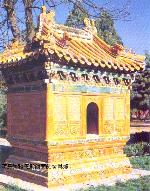 | |
For ancestor veneration, a kind of furnace (fenbolu 焚帛爐) is erected to burn silk messages to the emperor's soul. All buildings of the Ming and Qing emperors are painted in red and decorated with yellow glazed tiles, like the buildings of the Imperial City in Beijing. These colors have become standard colors of important buildings in China. |
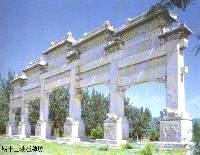 |
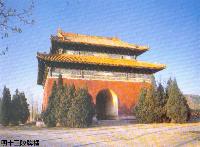 The whole complex of the Ming tombs is called Ming Shisanling 明十三陵 "13 tombs of the Ming Dynasty". The first gate is a symbolic honorific gate (paifang 牌坊) with six pillars and five entrances (left picture). From this gate to the gate tower (pailou 牌樓) Dahongmen 大紅門 "Great Red Gate", the street is flanked by marble or stone steles of officials and different animals. The whole complex of the Ming tombs is called Ming Shisanling 明十三陵 "13 tombs of the Ming Dynasty". The first gate is a symbolic honorific gate (paifang 牌坊) with six pillars and five entrances (left picture). From this gate to the gate tower (pailou 牌樓) Dahongmen 大紅門 "Great Red Gate", the street is flanked by marble or stone steles of officials and different animals. |
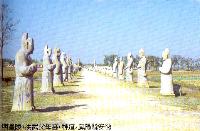 |
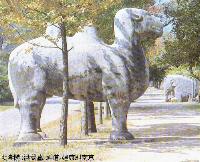 Not only the reigning emperors, but also their princes had their own tomb. The father or ancestors of a dynasty founder were also entitles with a posthumous title as if they had been emperors. The first Ming 明 emperor's parents were buried in Fengyang 鳳陽/Anhui in the Ming Huangling 明皇陵 "Imperial Tomb" burial mound. The picture to the left gives an impression of the soul path (shendao 神道) of this tomb area with the stone steles (shixiang 石像). The picture to the right is taken in Nanjing, where the first Ming emperor is buried in the Ming Xiaoling 明孝陵 "Filial Tomb" site, showing camel and elephant of the soul path. Not only the reigning emperors, but also their princes had their own tomb. The father or ancestors of a dynasty founder were also entitles with a posthumous title as if they had been emperors. The first Ming 明 emperor's parents were buried in Fengyang 鳳陽/Anhui in the Ming Huangling 明皇陵 "Imperial Tomb" burial mound. The picture to the left gives an impression of the soul path (shendao 神道) of this tomb area with the stone steles (shixiang 石像). The picture to the right is taken in Nanjing, where the first Ming emperor is buried in the Ming Xiaoling 明孝陵 "Filial Tomb" site, showing camel and elephant of the soul path. |
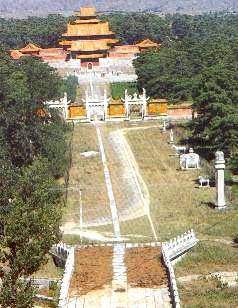 |
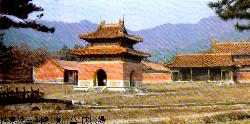 The tombs of the Qing 清 emperors can be found in two different areas: The eastern area (Qing Dongling 清東陵) in Zunhua 遵化/Hebei with the tombs of Shunzhi 順治, Kangxi 康熙, Qianlong 乾隆, Xianfeng 咸豐; and the western area (Qing Xiling 清西陵) with the tombs of the Jiaqing 嘉慶 and other emperors. The large picture to the left demonstrates the entrance area of the Jiaqing Emperor's tomb Qing Changling 清昌陵 "Shining Tomb". After crossing a bridge and following a soul path, the visitor enters a threefold gate. Only then he can pass the gate into the wall enclosure with the three buildings. The picture above shows the main entrance to the Qing Xiaoling 清孝陵 "Filial Tomb" of the Shunzhi Emperor 順治. The tombs of the Qing 清 emperors can be found in two different areas: The eastern area (Qing Dongling 清東陵) in Zunhua 遵化/Hebei with the tombs of Shunzhi 順治, Kangxi 康熙, Qianlong 乾隆, Xianfeng 咸豐; and the western area (Qing Xiling 清西陵) with the tombs of the Jiaqing 嘉慶 and other emperors. The large picture to the left demonstrates the entrance area of the Jiaqing Emperor's tomb Qing Changling 清昌陵 "Shining Tomb". After crossing a bridge and following a soul path, the visitor enters a threefold gate. Only then he can pass the gate into the wall enclosure with the three buildings. The picture above shows the main entrance to the Qing Xiaoling 清孝陵 "Filial Tomb" of the Shunzhi Emperor 順治.
The subterranean chamber of the Qianlong Emperor's 乾隆 tomb (Qing Yuling 清裕陵 "Blessed Tomb") can be visited, also the tomb of Empress Cixi 慈禧太后, Dingdongling 定東陵, a satellite tomb east of the Xianfeng 咸豐 Emperor's burial mound Dingling 定陵. |
|
|
|